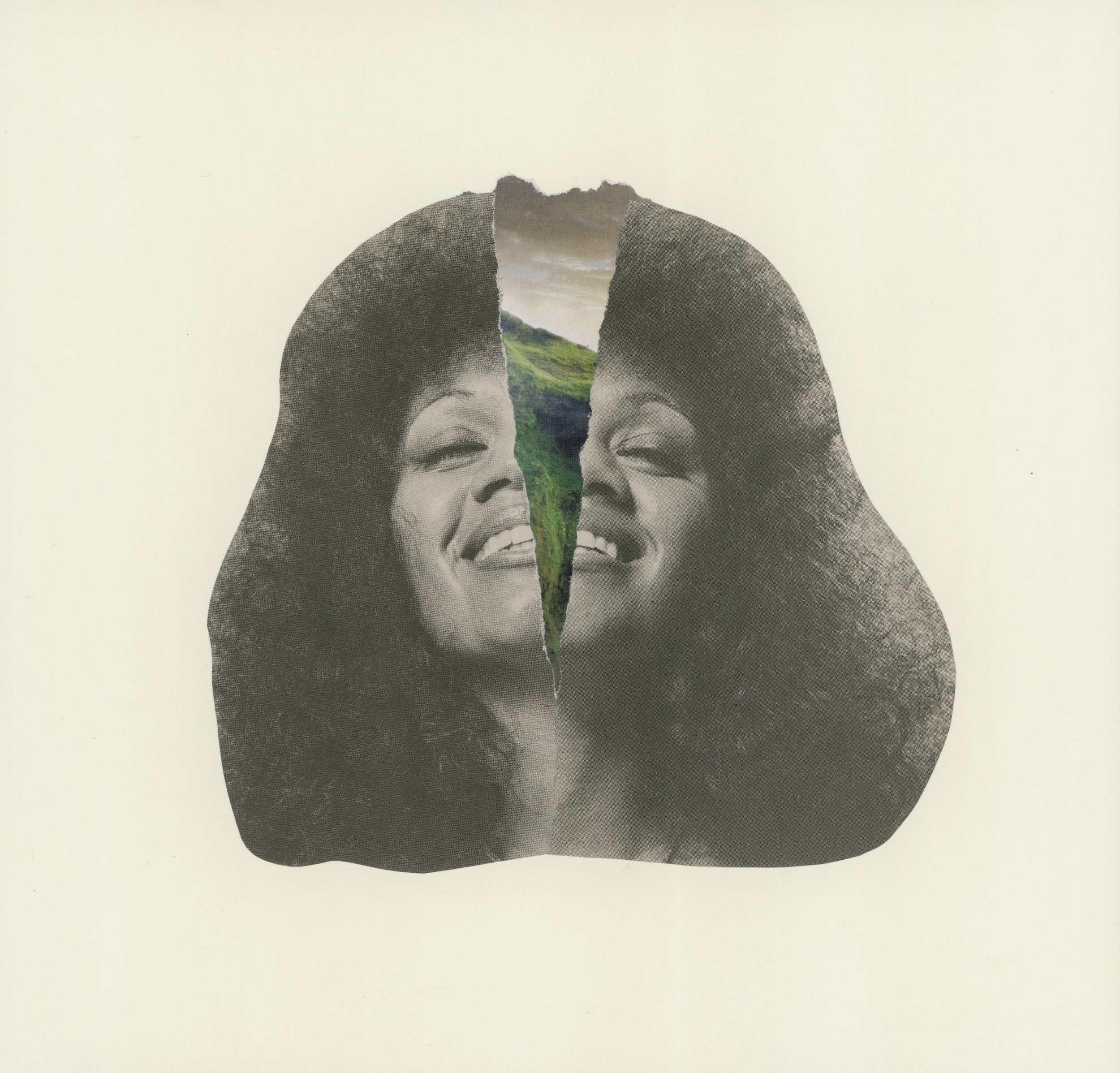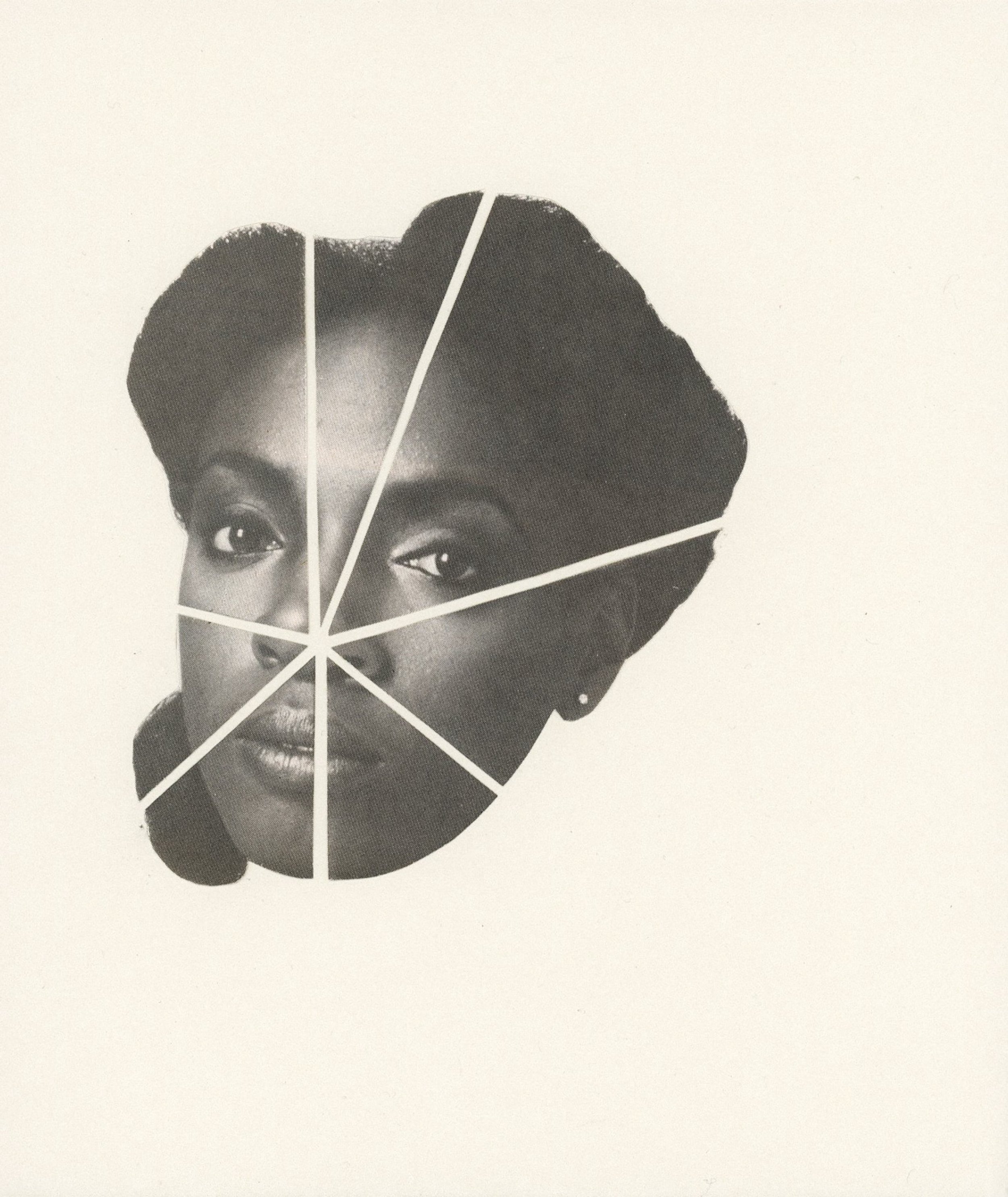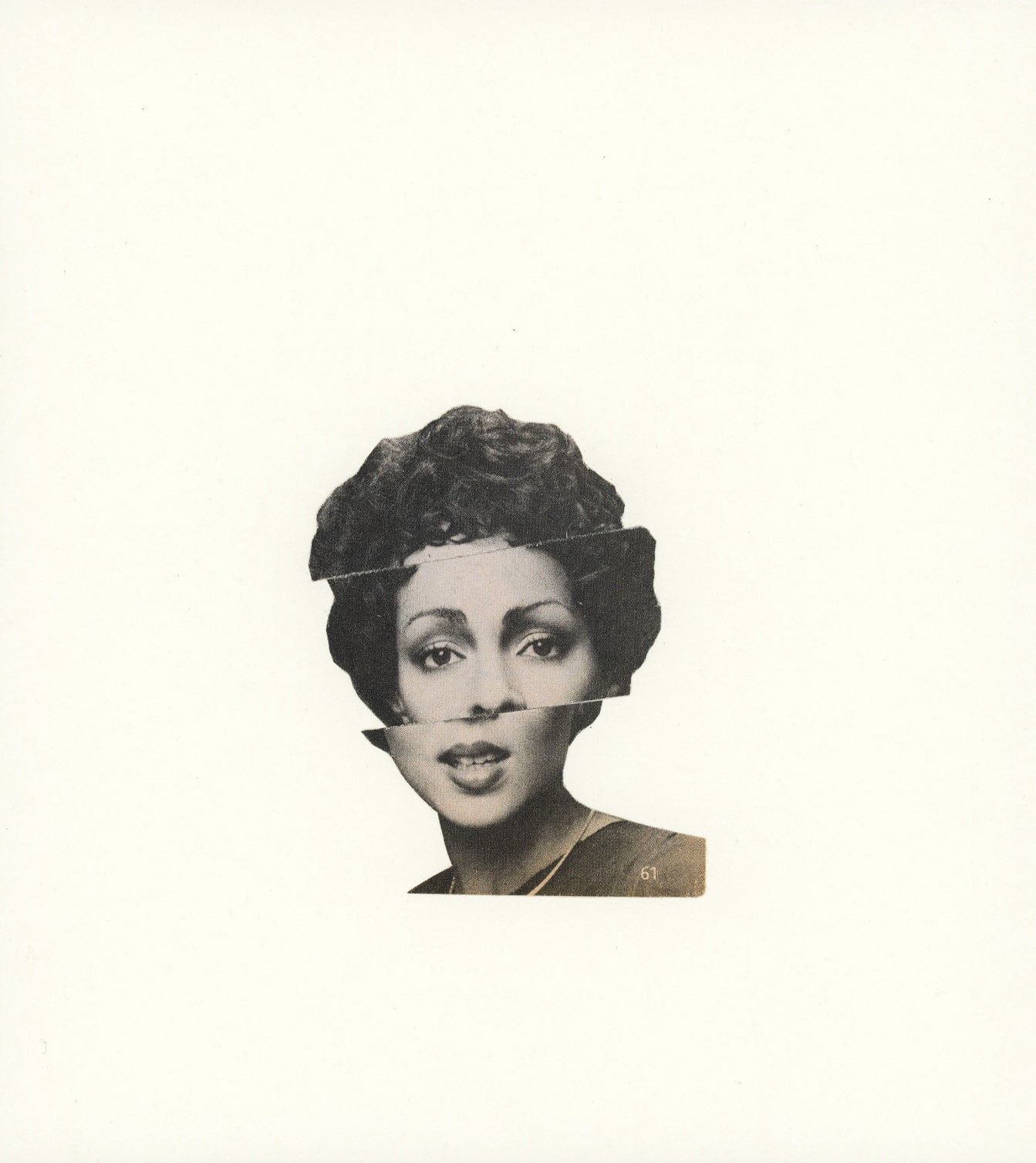Alexandria Valentine photographed by Jalen Hamilton
Photo courtesy of the artist
Damaris Athene: Could you start off by telling me about yourself please Alexandria?
Alexandria Valentine: I'm from the South Side of Chicago, born and raised. My family that came over during the Great Migration is from Mississippi and Arkansas, so I like to say that I’m from Chicago byway of Mississippi and Arkansas. I'm a writer, a poet, a visual artist, cultural worker, archivist, and a human!
DA: What does your visual art practice involve?
AV: I'm primarily working in collage right now. I've been mostly working with Blac Tress magazine. It’s a hair magazine catered to Black women, featuring different hairstyles, products, horoscopes, and articles. The magazines I’ve found are primarily from the 70’s and 80’s. I really enjoy this magazine specifically because there's a lot of portraiture in it. It's very different from the sorts of magazines we see now, there’s a very unique artistic hand in it, something quiet about the photos. I'm also using National Geographic magazines, which is kind of funny, because my mom used to buy me National Geographic magazines when I was little. I didn’t cut them up then, I would just flip through the pages, fascinated at all these different places that existed outside of my own neighbourhood. It's interesting that I’ve come back to that. I'm fascinated with landscapes and I’m drawn to combining them with the women in the Blac Tress magazines. I have a series I’ve been working on, on and off, called ‘Planetary Feelings,’ where I combine a portrait from Blac Tress and a landscape from National Geographic. I’m trying to get at the way our feelings and emotions mirror the patterns of the natural world and the solace that can be found in using the natural world as a way to represent feelings that we do not yet have a name for. As far as future endeavours go, I'm preparing for a show in May here in Chicago at Heaven Gallery where I’m working with photos from my family archives. So, I'm switching gears and that's really exciting. There's a different pressure when you're working with images of family, though. I feel even more precious with the imagery and it can be tricky to even move forward, but I’m excited about where the work is going.
Black and Blue Series 05, 2020, Collage on paper, 7.5’’ x 8’’
Photo courtesy of the artist
DA: How did you first come across the Blac Tress magazines?
AV: I really love eBay and Etsy and sometimes I go down rabbit holes. At the beginning of the pandemic I was in a writing program at Columbia University and I was trying to force myself to make visual work but my brain was just like, “No!” When I got out of grad school, I finally had the mental space to work on visual work and started to look for source material. I typed in ‘vintage Black magazines’ and they popped up. I'd never heard of Blac Tress before then. That's one of the reasons I love eBay and Etsy because you can find things that you never in a million years would have thought existed. I’m also a homebody so being able to do so much exploring from the comfort of my bed is perfect.
DA: Were you working with collage before you discovered Blac Tress magazine or has it always been your art form?
AV: It's been a bit of a journey. I went to the School of the Art Institute of Chicago, for fashion design actually. When I got in the department I didn’t enjoy it. I like to take my time and that's not what the fashion industry, as I understand it, is about. I like art because it gives me a chance to slow down, space to spend time with myself and to make things that I'm proud of. The fashion design program I was in was the complete opposite of that for me, it was pure chaos. After leaving the fashion department I was in this weird liminal space where I was like, okay, I don't want to do fashion anymore, so what am I going to do? I always loved journaling and writing for myself, so I thought why not try out writing? I took an intro to writing class with Suman Chhabra and fell in love. Even so, I really still had the urge to do something more with my hands. When I was in the fashion design program, instead of drawing clothes on my figures I used to collage them so I went back to that, but instead of collaging clothes I just did whatever felt good.
DA: Do you find that your writing feeds into your visual art and vice versa?
AV: Yeah, for sure. I think everything really starts with the writing. In my writing I'm asking questions or trying to figure things out and the art is an extension of that. There's this quote by James Baldwin, in his essay ‘The Artist’s Struggle for Integrity’, where he says “The poets (by which I mean all artists) are finally the only people who know the truth about us. Soldiers don’t. Statesmen don’t. Priests don’t. Union leaders don’t. Only poets.” I think about that quote a lot, poets, writers and writing is kind of my North Star. I’m always returning back to a line in a book, a quote by my favourite author, a poem, my own journal—that’s sort of the engine that keeps everything else going for me.
Through the Valley, 2021, Collage on paper, 7’’ x 7’’
Photo courtesy of the artist
DA: Do you ever exhibit your writing alongside the collages?
AV: I haven't done that in a while. A couple years back, I took a text and image class, and I really enjoyed it. That’s definitely something I want to get back to.
DA: I'd be interested to see how that looks. When did you first become interested in archives?
AV: My grandpa was always taking photos of our family and my mother was also very into documenting me growing up. My grandpa used to always let me use his Polaroid camera so I could take my own photos of the family, which was really cool now that I think about it, trusting like a five year old with your favourite camera. I think it started there, with the idea of being able to archive myself. It’s something that gave me agency over my own narrative at a very young age whether I realised it then or not. That was something I was very interested in as a child and it fizzled out as I grew up. It came back up when I was moving through a lot of predominantly white spaces in college and in grad school. I was looking for something to ground me. Being a Black American, there's so much of our history that we've been purposely divorced from, and so much that we just don't know because of the transatlantic slave trade. So this process of archiving is me trying to hold on to what we do have. So I started asking my grandma and great aunt for photos, and tracking down photos throughout our family. I don't want these photos to go missing. I want to digitise them and hold onto as much history as I can. This search for photos also led me to have these conversations with the women in my family about their lives and experiences. When I ask them questions, I get these answers that I never would have expected, The stories that they tell me are really interesting. When my grandmother talks sometimes it feels like I’m reading a Toni Morrison novel. After getting my grandma talking, I asked her, “Why haven't you ever mentioned these things before?” and she said, “Nobody ever asks!”
DA: Do you record any of those conversations?
AV: Sometimes they happen by accident, and I wish I was recording. I am starting to record things, especially because my grandmother is hilarious! And I want to be able to hear it back in her voice.
In Wait, 2021, Collage on paper, 9.5’’ x 10.5’’
Photo courtesy of the artist
DA: That would be a lovely thing to do. In your artist statement you mention Black latent thought, ancestral landscapes, and the Black Romantic; how do you explore these within your practice?
AV: Black latent thought is a term I coined that speaks to the unique landscape of Black subconscious thought and points to the idea of a larger interconnected Black collective subconscious that includes the joys, traumas and experiences that are unique to us as a people. I needed a word for what I was interested in, so I came up with one. I'm really getting to this idea of the subconscious in my work, in both my writing and my visual work. We’re existing in one way, in front of people and in the world, but what's going on behind all those layers? What are the things that are actually making up who we are as people and perhaps the things that we don't like to talk about or don't want to talk about, but that are there. I'm really interested in psychology, it was one of my favourite subjects in high school. In regards to ancestral landscapes, I've been talking to family members and I’ve been trying to visually imagine the landscapes they're explaining to me. They were in Arkansas and had a farm, some of my family lived in Natchez, Mississippi in a place where my great-aunt describes the soil as being reddish. I’m working through understanding what those landscapes meant to them and what they mean to me. My grandma was telling me a story about her grandmother, Pauline Donald, who had a horse and was super badass. These stories make up the memory landscapes my work is concerned with. It's really nice to be able to look at the National Geographic magazines and take out landscapes that perhaps I've never had an actual physical relationship with, but feel drawn to. I think like, how does this relate to the emotion that's on this person's face? Or how does this relate to that one story that my grandmother told me? I would love to be able to have physical relationships with these landscapes but for now I can use National Geographic as a way to see these different places. The Black Romantic is a term that I became interested in after reading an essay on Studio Harlem’s website by a friend of mine, Jada-Amina. They mentioned the Black Romantic in their essay, and something clicked. I was like, Oh, that's such an awesome concept. Their definition of the Black Romantic is “the unique way in which Black people express sentimentality, through our affections for one another, our culture and adornment.” When I think of the Black Romantic, I'm thinking about romanticism and the exploration of solitude, holding nature in high esteem, respect for the spiritual and the world unseen. I'm also thinking about my grandmother and my mother, and the way they live their lives. The way they dress, the perfumes they wear, the way they decorate their homes. There's such a sense of romanticism there. The world has been very harsh and difficult, but they’ve found beautiful ways to exist and survive within it, that’s romantic to me. It feels like they're having this love affair with themselves and the world around them.
Black and Blue Series 03, 2020, Collage on paper, 7’’ x 7’’
Photo courtesy of the artist
DA: Those weren’t terms that I came across before, so thank you for explaining all of that. What draws you to work with collage?
AV: Accessibility is my favourite part of it, but I'm also finding catharsis in being able to take something completely apart and then put it back together. Especially, in these wild times we're living in it feels things are coming apart and they're never getting put back together. Collage gives you that control to say, okay, I can take this apart as much as I want to, but it can come back together again. Nothing's ever fully lost.
DA: How would you usually work and has that been affected by the pandemic?
AV: I tend to work by myself a lot and I'm still working by myself a lot so it hasn’t changed that much. I have a studio mate now, which is nice. People can be cool!
DA: Do you think it's changed what you're exploring or thinking about in your work?
AV: Yeah, I think it's turned me in towards the idea of Black latent thought for sure. It’s something I've always been interested in, but I think it's pushed me there more, because I‘m spending all this time by myself and aspects of myself that usually simmered more in my subconscious are coming forward and making themselves known. It's pushed me towards wanting to know what is going on in my brain and the brains of other people.
DA: Whose work inspires you?
AV: There's an artist named Shabez Jamal. Primarily, I believe he's a photographer and anytime I see his work on Instagram he surprises me. I'm always waiting to see what new things he's doing. Also, a good friend of mine and colleague that I mentioned earlier, Jada-Amina, is inspiring to me. They're a collage artist, video/sound artist and singer. It trips me out that they’re on so many planes. I’ve listened to one of their songs so many times, like a quarter of the listens on Spotify for that song might just be from me! I also really enjoy the work of Lorna Simpson, Toni Morrison, and Deborah Roberts. Their work feels so kindred to me. If I'm stuck, they help me get unstuck.
Pieces, 2021, Collage on paper, 12.5’’ x 15.5”
Photo courtesy of the artist
DA: A great selection! What projects have you been working on recently?
AV: Too many! I'm in this show called ‘Resplendent’ in Baltimore that opens in March at Baltimore Connect Gallery. It's curated by Teri Henderson, a pioneer in the Black collage movement. She recently put out a book called 'Black Collagists', which I was lucky enough to be a part of. The show is about Black women in standards of beauty and advertising and popular culture. I’m working on my largest piece to date which is anxiety inducing, it's about 30 by 40 inches. I normally work very small. I’m working with an image that I found of my grandmother. It’s a graduation photo where she’s in this big dress and she looks like she should be in a cotillion or something. I’m also working with some of the images from the Blac Tress magazine.
DA: Did you scan the images and blow them up? Or have lots of small images on a big sheet of paper?
AV: I scanned it. Scanners are like heaven sent it. For the images from Blac Tress magazine, I pieced them together from the regular size, taking them straight out the magazine. I also have a show at home in Chicago at Heaven Gallery that opens, May 20th. It's called ‘This Way Home’ and that's something I'm still working through. I'm one of those people that, instead of trying to do everything late, I try to do it super early, because it's so anxiety-inducing to try to wait till last minute where I worry everything is going to go wrong. I'm working on collage pieces and might be working on some text paintings using my grandmother’s language from some of the stories that she's given me in the phone interviews we did.
DA: So lots of exciting things in the pipeline!
AV: Yeah, I'm excited and I'm a little nervous!
Macrocosm, 2020, Collage on paper, 7’’ x 7’’
Photo courtesy of the artist
DA: What other plans do you have for future work?
AV: I'm going to be working more with my family archives. I'm sure I'll still be dipping in and out of the Blac Tress magazines, because I still have a ton of them and lots of imagery left to work with. I'm also trying to push myself to work in different mediums. I was kind of scared of screen printing at one point, because during undergrad the class I was taking was moving too fast for me, and I thought it wasn’t my thing. But I actually like it, I just needed to take my time. The text paintings I’m working on are going to be screen prints.
DA: That sounds great. I'm looking forward to seeing the screen prints. It could look really nice combined with the collage, you could screen paint over the top.
AV: Yeah!
DA: Thanks so much Alexandria, it was lovely talking to you about your practice.
AV: Thank you!







